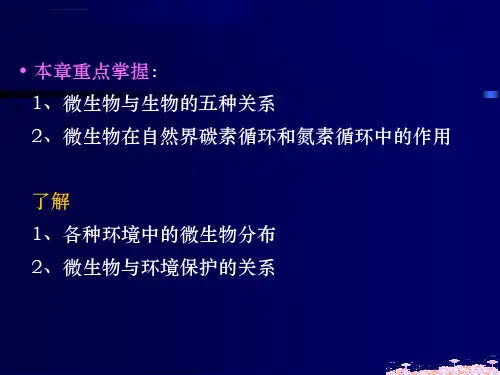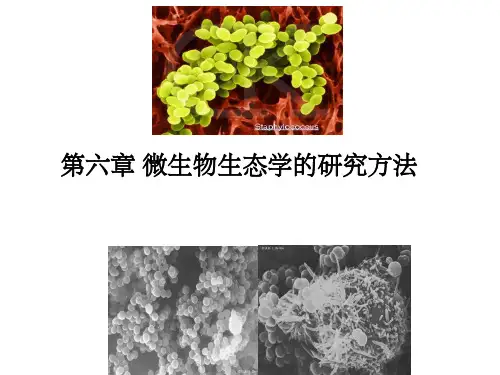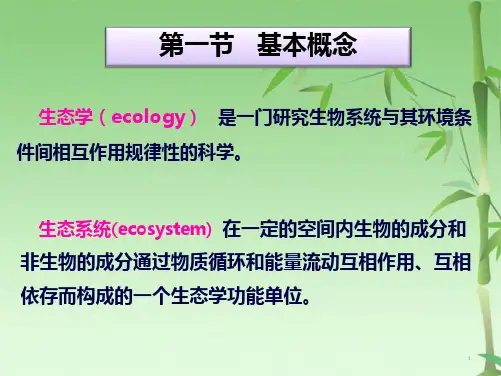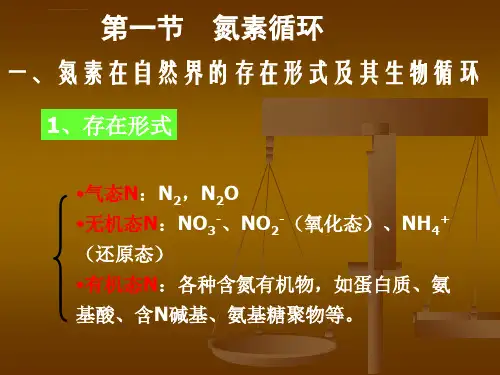- 1、下载文档前请自行甄别文档内容的完整性,平台不提供额外的编辑、内容补充、找答案等附加服务。
- 2、"仅部分预览"的文档,不可在线预览部分如存在完整性等问题,可反馈申请退款(可完整预览的文档不适用该条件!)。
- 3、如文档侵犯您的权益,请联系客服反馈,我们会尽快为您处理(人工客服工作时间:9:00-18:30)。
Current research progress
• Mustard (Brassica juncea) and Cr -resistant strains .
applied to Mustard Increase biomess
Cr-resistant strains
plant
resault
• Cr -resistant strains Pseudomonas sp. PsA4 and Bacillus sp. Ba32 applied to mustard (Brassica juncea) . • The results showed that vaccinated PsA4 mustard or Ba32 have increased in 95.3 mg / g and 198.3 mg / g Cr (6 +) biomass in the soil.
• A kind of parasitic bacteria in plant body, all plants have endophytes. • Endophytic bacteria (PGPB) is a kind of parasitic life, promote the growth of the host . • Can enhance plant resistance to pathogens, drought, heavy metal.
• As a new way, biological control has huge potential, but is still in its infancy. With further research, it is expected to find more microbial resources, and developing new technologies to make practical applications possible.
Alage
• Wide distribution, a good biological adsorbent. • The walls of algae has a larger surface area. • Cell walls have a certain charge and viscous, these characteristics make the metal ion has the ability.
Scenedesmus Obliquus
• Has a larger adsorption capacity to UO22 +. • The UO22 + concentration in the water from 5.0 mg/L fell to 0.05 mg/L.
Endophytic bacteria
Prospects
• Heavy metal contamination of soil growing problem in many options in phytoremediation has its unique advantages, the focus of the problem is how to increase the resistance of plants to heavy metals.
Oxidation reduction
• many microbial oxidation or by reduction (in most cases) from the high toxicity of the heavy metal transformed into less toxic valence valence state, thereby lifting the heavy metal toxicity.
• Castor (Ricinus communis) and nickel, zinc resistance strains.
isolate
electe
inoculate
increase
• isolated from the rhizosphere soil microbes , after nickel, zinc resistance screening . • elected the heavy metal resistant strains Pseudomonas sp. And Pseudomonas jessenii. • inoculated them to castor (Ricinus communis), they found a significant increase castor biomass , and increased the accumulation of Zn, Ni, Cu 's .
Mode of resistance to heavy- metal
• Release of chelating agent and iron carrier. • Acidification of the soil environment, • Change the REDOX potential. • Reduce the absorption. • Increase the discharge • Oxidation reduction
Page 2
Page 3
Bioremediation on heavy metals
Page 4
Metal resistance of microorganisms
Plant rhizosphere bacteria
Plant endophytic bacteria
Page 5
Rhizosphere bacteria
Mechanisms of resistence to heavy -metal
Reduce
Oxidation
Adsorption
Interactio n Acidificati on
bonded
Increase
Reduce the absorption the heavy metal content in the microbial cells at a low level is maintained without causing toxic effects on cells. As a type of staph resistance of Cd2 + is the case.
Bacteria
• Widely distributed, many varieties, fast metabolism and reproduction.
• Chemical composition of bacterial cell walls contain many heavy metal ions adsorption groups, such as carboxyl, amino, hydroxyl .
Adsorption
Many microbial cell surface has a special structure, can absorb heavy metal ions and thus to reduce the concentration of heavy metal ions in solution.
Increase the discharge
• some microorganisms may be proactive manner by heavy metal ions within the cell is discharged outside the cell, thus maintaining low levels of the cell. • As one kind of resistance to Bacillus copper.
• From Elsholtzia splendens and duck plantar grass (Commelina communis) .
• Firmicutes ,Actinobacteria, Proteobacteria. • These bacteria strains in copper resistance of main groups .
Saccharomyces Cerevisiae
White-rot fungi adsorbe Pb2 + ,the
highest removal rate can reach 95%.
Black rhizopus adsorbe Ag +, Pb2,
Li + and Cd2 +, Zn2 + and Ni2 +, Cu2 +, such as heavy metal ions.
The Cr6+ resistant plant growth promoting bacteria (PGPB), Pseudomonas sp. PsA4 and Bacillus sp. Ba32 were isolated from heavy metal contaminated soils and their plant growth promoting activity on the Indian mustard.
• Grow in plant root system . • With bacteria, actinomycetes, fungi, algae, and the protozoa. • Alternate relationship between them and plant. • Plant roots interaction and promote each other.






